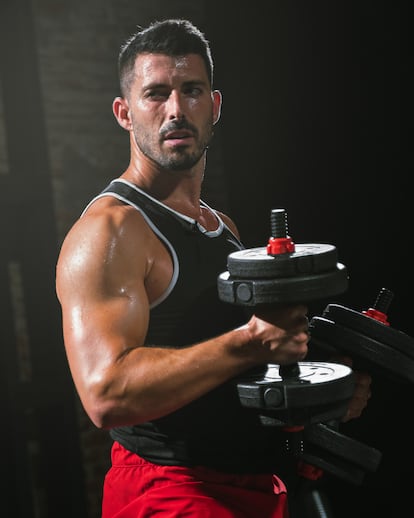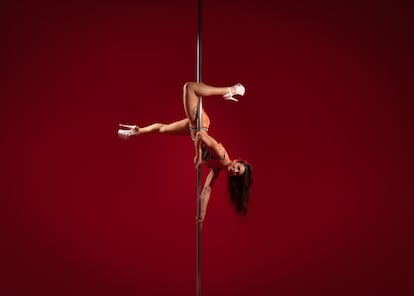Fitness, butts and Instagram stories: How exercise is sexualized on social media
Posts of women in their underwear are 54% more likely to show up in feeds; posts of men with bare torsos, 28% more likely. This has repercussions on what content creators’ posts look like

A couple of months ago Laura Kummerle tried uploading something different to her Instagram page. She’d been posting fitness routines for several years, so the exercises weren’t entirely new. But the camera shot was different: it focused directly on her butt, sexualizing the entire result. What happened next came as a surprise to no one, except Kummerle herself. To tell the truth, she didn’t expect such a brutal response; in a video a week later, she admitted that it was an experiment.
Her post multiplied the views she normally receives; comments and revenue soared as well. “There was a huge increase in sales of my programs and requests for private lessons,” she said. “I had noticed other creators sexualizing their bodies. I thought it was some sort of attention-seeking, but I’ve seen that there’s a direct correlation between this and sales,” she concedes.
Social media prioritizes slightly sexualized content. It’s nothing explicit, but it is suggestive. Sex sells and, at the end of the day, the social media website Instagram is a big market. Sexualization affects all users, but there are segments where it is more apparent. On recipe, travel and book channels, the body plays a more secondary role. But in exercise and sports, a community with over 50,000 content creators, according to some studies, it is much more evident. The result is a trend that has been worsening in recent times. “It’s the sexualization of the fitness industry,” Kummerle notes. “And I have some thoughts on it.” The Georgia-based U.S. gymnast has been working out her whole life. She works out in tights and tight-fitting clothes. She knows that she has to show her body to teach viewers how to perform an exercise well. But she believes that there is a clear line between sport and sex. And she feels that many of her peers have crossed that line.
Nicolas Kayser-Bril, an analyst at the NGO Algorithm Watch, backs up Kummerle’s feelings with data. He conducted an experiment in which 2,400 photographs were analyzed by installing a program on 26 Instagram users’ pages. He found that posts containing photos of women in underwear or bikinis were 54% more likely to appear in the feed. Posts with pictures of men with bare torsos were 28% more likely to appear in the feed. Conversely, if the photos featured food or scenery, they were about 60% less likely to appear in the news feed.
“Some of the accounts we were following were Instagrammers who specialized in analyzing feminist books,” the analyst points out in a phone conversation. “There was no chance that their audience would reward that kind of content. But the effect was clearly noticeable even there.” Given this study, Kayser-Bril is convinced that this is not a salacious issue but an algorithmic one. “Maybe a lot of people prefer sexier content or whatever,” he acknowledges. “But it’s not just that. It’s very difficult to audit these kinds of systems, but the algorithm plays a role in it.” The expert isn’t even sure that it’s that way by design. It may be the result of the amount of porn moving around in the cesspools of Instagram.
“Instagram censors porn when it detects it, but it doesn’t see it immediately,” he explains. That’s why there is a network of new users who post this type of content to gain followers quickly. They then delete the photos and sell the accounts on channels like socialtradia.com. For €150 ($158.49), you can become an influencer with thousands of horny followers.
These accounts lurk beneath the surface. “It’s like a sinkhole, like the sewers of Instagram, but even if we don’t see it, it’s huge in terms of clicks and numbers,” Kayser-Bril points out. Even if it flies under the radar of censors and most users, it penetrates the bowels of the app and changes what the app understands the average user likes. It’s not that Instagram users are out of touch but that its algorithms are. When asked about it, Meta refers to the company’s blog, which says that the order of the Instagram feed is based on “a series of predictions about the stories that you will find most relevant and valuable,” taking into account factors like viewing history, interactions and the connection you have with the author of the post in question.

Trainer Sergio Peinado starts by stating a truism and goes on to develop a well-articulated argument. “Physical looks are important in society,” says the exercise science graduate and content creator. That is even more true on Instagram, especially accounts that talk about exercise. Peinado recognizes that part of it has nothing to do with sex: “The public wants to look like you, there is this bias that if you have a good body, you have more authority,” he reflects. “But it is false, because that depends on genetics, food or even supplements, things that are not always seen on social media.”
Taking all this as a given, there is a line — a diffuse and subjective line — that separates sporty from racy. “Of course, if you sexualize your content you will have more influence in the short term,” Peinado concedes, “but I don’t know if it’s worth it, I don’t know if you build community this way.” In his case, he was clear about where to draw that line. Social media is great and all content is lawful, he says; there is room for everyone to build their profile and community. “I’ve seen colleagues who have started in the fitness world and sexualized themselves until they ended up on Onlyfans [a paid content platform that is usually sexual], because they saw that it worked better for them,” he concedes. While that is fine, it’s not what he wants.
In addition to impacting creators, sexualization also impacts consumers of content. The primary effect is biological and does not need much explanation. But there may be some secondary effects on body self-perception and satisfaction. Research suggests that exposure to a standard, thin, and often sexualized beauty ideal may reduce body satisfaction in social media users, especially adolescent females. However, it is not clear that sexualization is a determining factor in this equation. A University of Padua study attempted to find out. A group of young people were exposed to three sets of photos on Instagram. The first showed sexualized beauty ideals; the second, sexualized body positivity; and the third, non-sexualized body positivity. The results showed both beneficial and critical aspects and concluded that sexualization on Instagram need not have a negative impact if it is treated respectfully and conveys a message of self-acceptance.

Carolina Are, a sociologist and digital criminology researcher at the University of New Castel believes that sexualization on social media is not a bad thing. It empowered her. In addition to being a researcher, Are is a pole dancer. She studies how social media shows and hides women’s bodies. And she observes that Instagram is increasingly prudish.
“There is a paradox in this, as many researchers point out,” she explains in an audio exchange. “The most artificial and more mainstream form of involuntary sexualization is represented by celebrities and pushed by the algorithm. But more personal content and content from people who come from more marginal contexts are censored. So, in the end, we see that sexualized content reflects power dynamics,” Are summarizes.
The sociologist believes that sexualizing oneself is a form of empowerment, a way to take control of one’s own body and present oneself to the world. For this reason, she says that doing so by choice on social media is a positive thing. She contrasts this idea with the sexualized world sold by advertising and traditional media, where a woman doesn’t sexualize herself; the system does. Are says that social media sites are copying this model and penalizing those who go outside the norm. “They promote only the types of sexuality that sell,” she notes. Here, she might agree with Kummerle. On Instagram, sex sells.
Sign up for our weekly newsletter to get more English-language news coverage from EL PAÍS USA Edition
Tu suscripción se está usando en otro dispositivo
¿Quieres añadir otro usuario a tu suscripción?
Si continúas leyendo en este dispositivo, no se podrá leer en el otro.
FlechaTu suscripción se está usando en otro dispositivo y solo puedes acceder a EL PAÍS desde un dispositivo a la vez.
Si quieres compartir tu cuenta, cambia tu suscripción a la modalidad Premium, así podrás añadir otro usuario. Cada uno accederá con su propia cuenta de email, lo que os permitirá personalizar vuestra experiencia en EL PAÍS.
¿Tienes una suscripción de empresa? Accede aquí para contratar más cuentas.
En el caso de no saber quién está usando tu cuenta, te recomendamos cambiar tu contraseña aquí.
Si decides continuar compartiendo tu cuenta, este mensaje se mostrará en tu dispositivo y en el de la otra persona que está usando tu cuenta de forma indefinida, afectando a tu experiencia de lectura. Puedes consultar aquí los términos y condiciones de la suscripción digital.
More information
Archived In
Últimas noticias
Most viewed
- Reinhard Genzel, Nobel laureate in physics: ‘One-minute videos will never give you the truth’
- Oona Chaplin: ‘I told James Cameron that I was living in a treehouse and starting a permaculture project with a friend’
- Pablo Escobar’s hippos: A serious environmental problem, 40 years on
- Why we lost the habit of sleeping in two segments and how that changed our sense of time
- Chevy Chase, the beloved comedian who was a monster off camera: ‘Not everyone hated him, just the people who’ve worked with him’











































